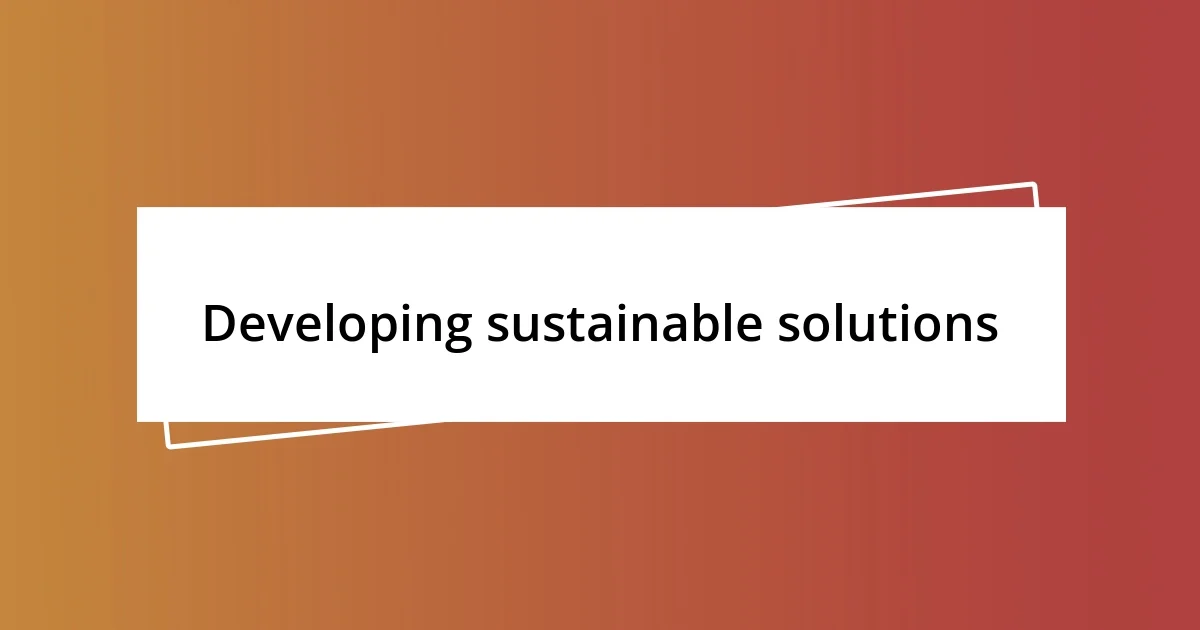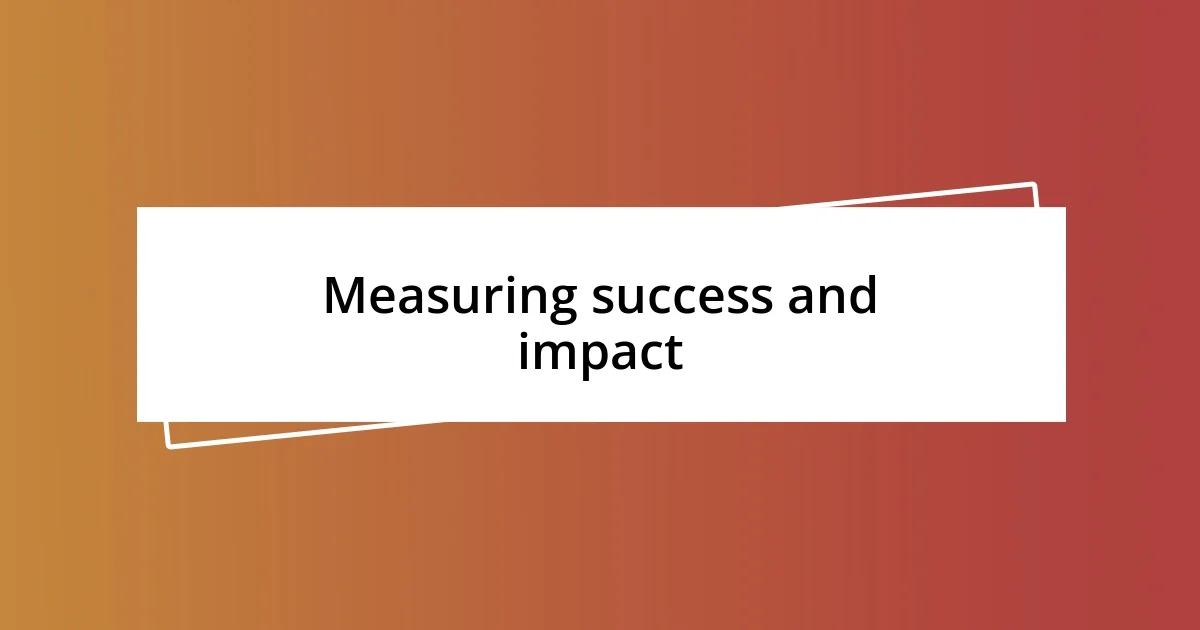Key takeaways:
- Food deserts are not just about lack of grocery stores; they also reflect systemic issues like income inequality and transportation challenges affecting residents’ access to healthy food.
- Community engagement and collaboration with local organizations are crucial for effectively addressing food deserts and ensuring solutions are tailored to residents’ needs.
- Measuring success involves personal stories of transformation and empowerment, illustrating that positive change in food choices can have lasting impacts on families and communities.

Understanding food deserts
Food deserts are areas where residents have limited access to affordable and nutritious food. I’ll never forget the first time I visited one of these neighborhoods; the stark contrast between the colorful, bustling farmer’s markets I knew and the empty shelves in local stores was shocking. It made me question, how can a person lead a healthy life when fresh produce is practically out of reach?
In my experience, food deserts aren’t just about a lack of grocery stores. They often represent larger systemic issues, like income inequality and transportation challenges. Imagine having to travel miles just to buy a head of lettuce—it’s frustrating and disheartening. In these communities, convenience stores filled with processed foods become the norm, leaving residents with few healthy options.
One of the most heart-wrenching moments I encountered was conversing with a single mom trying to feed her children. She expressed the anxiety of wanting to serve them wholesome meals but being forced to settle for what’s available. It made me realize that encountering a food desert can be isolating, creating a cycle of poor nutrition that affects not just physical health, but mental well-being too. Have you ever wondered how something as fundamental as food can become such a pressing issue?

Identifying food desert areas
Identifying food desert areas requires a keen understanding of both geography and community needs. I remember driving through a neighborhood, tempted to ignore the stark surroundings, yet something urged me to look closer. I saw many families living in the vicinity of small convenience stores, but there wasn’t a single fresh produce section in sight. This moment made me realize that an area could be categorized as a food desert even if there were shops—what really mattered was the quality and accessibility of the food offered.
The U.S. Department of Agriculture (USDA) defines food deserts using specific criteria, such as low-income populations and a significant distance from grocery stores. From my time volunteering with local organizations, I’ve learned that simply looking at the number of food retailers isn’t enough. You also have to analyze local transportation options and income levels. Imagine a senior citizen, reliant on public transport, facing a two-hour journey just to buy fresh fruits and vegetables. It paints a stark portrait of what it means to live in a food desert.
In my experience, identifying these areas also requires conversations with residents. One day, while talking to a community leader, she shared stories of families shopping for groceries in other neighborhoods, often using buses with limited schedules. It struck me profoundly how critical it is to listen to those living in these situations. By doing so, we can recognize the real obstacles they face, ensuring that when we work to improve access to healthy food, we do so with their needs in mind.
| Criteria | Description |
|---|---|
| Distance to Grocery Store | Generally over 1 mile in urban areas or over 10 miles in rural areas |
| Income Level | Households below 200% of the poverty line |

Researching community needs
Researching community needs is an essential step in tackling food deserts. I vividly remember visiting a community center in a neighborhood largely overlooked by grocery chains. Sitting down with local residents, I was struck by their stories; they discussed not only the lack of fresh food options but also the emotional toll it took on their day-to-day lives. One woman recounted how her children would ask for fruits and vegetables, but their only choice was the snacks from a nearby corner store. It reinforced in me just how vital it is to really listen and connect with the community before proposing any solutions.
To guide my research, I focused on key factors like:
- Access to Transportation: How far are residents traveling to reach grocery stores?
- Income Levels: What percentage of families are living below the poverty line?
- Cultural Preferences: What types of foods do community members wish to have access to?
- Health Statistics: Are there specific health issues prevalent in this community that could be tied to diet?
- Local Initiatives: Are there existing efforts, like community gardens or food banks, that might be leveraged or supported?
Understanding these elements helped me paint a clearer picture of the community’s unique needs. Each data point revealed a layer of their story, proving that when it comes to food deserts, one-size-fits-all solutions just wouldn’t work.

Collaborating with local organizations
Working alongside local organizations has been a game-changer for my efforts in addressing food deserts. One memorable moment came when I partnered with a local food bank. We organized a community event where families could not only pick up groceries but also participate in meal-planning workshops. Seeing neighbors come together, sharing recipe ideas and bonding over food, illuminated just how impactful collaboration can be. Isn’t it amazing how food can unite people in meaningful ways?
Through these partnerships, I discovered a treasure trove of resources I was initially unaware of. For example, connecting with local farmers’ markets revealed opportunities for getting fresh produce into the hands of those who needed it most. One Saturday morning, I joined a team from a local nonprofit to distribute food directly in the neighborhood. The gratitude expressed by families was deeply moving. They weren’t just receiving food; they were gaining a sense of community and support that they had long felt was missing.
Additionally, I learned that collaboration isn’t just about sharing resources; it’s about pool knowledge and expertise. I vividly recall a discussion with a health organization that highlighted the importance of education on nutrition. They shared captivating statistics on how improved access to healthy food could lower rates of obesity in our area. I left that meeting energized, realizing that by working together, we could tackle not only access but also information gaps, ultimately reshaping the community’s relationship with food. How can we expect change if we’re not all pulling in the same direction?

Developing sustainable solutions
Creating sustainable solutions for food deserts means thinking beyond just food distribution. One evening, while brainstorming with a group of passionate locals in a community hall, I felt a spark of hope when one participant suggested cultivating a cooperative grocery store. It struck me how empowering the community could be if we developed a place that they owned—one that met their specific needs and preferences. Isn’t it incredible to think that food can not only nourish bodies but also foster ownership and connection?
Moreover, we started exploring urban gardening initiatives as an avenue for sustainability. I vividly recall my first visit to a vacant lot transformed into a thriving community garden. As residents tended to their plants, laughter and camaraderie filled the air. Everyone learned together, exchanging tips and taste-testing fresh produce. Witnessing their pride in growing their own food was a powerful reminder that sustainable solutions often grow from the ground up—not just in a metaphorical sense, but literally.
Additionally, I began incorporating educational workshops focused on nutrition and cooking techniques to complement these efforts. One particular workshop stands out in my memory: a single mother, who initially seemed hesitant, eventually took charge at the cooking station. The joy on her face as she prepared a dish with ingredients she’d never used before was indescribable. It made me realize that by providing knowledge alongside resources, we encourage not just informed choices but also confidence in their food journey. How transformative is it when people not only consume good food but also feel empowered to make it themselves?

Implementing outreach programs
Implementing outreach programs was crucial in extending our efforts beyond mere food distribution. I recall a specific outreach day where we set up tables at a local park, armed with informational flyers and plenty of vegetables to hand out. People stopped by, curious—some even skeptical—but as we shared recipe ideas and tips for incorporating these foods into their meals, I saw a change in their expressions. It turned into more than just giving away food; it became a conversation. How often do we forget that even a simple chat can spark interest and encourage healthier choices?
One of the most impactful initiatives I undertook was pairing local schools with our outreach efforts. I vividly remember walking into a third-grade classroom, filled with eager little faces. We talked about the importance of fruits and vegetables, and I brought along samples for everyone to taste. The excitement was contagious! As the children bit into fresh apples and crisp carrots, I realized that instilling healthy habits early could resonate throughout families. What if the next generation could pave the way for a healthier community?
Lastly, we didn’t just rely on traditional methods of reaching out. Social media became a powerful tool for us. I fondly remember an online cooking challenge where families shared their creations using the ingredients they received from us. The energy was electric as we watched videos of kids cooking with their parents, and the comments section bloomed with excitement and ideas. It was a reminder that, in nurturing awareness and enthusiasm through outreach programs, we can create a ripple effect—one that may inspire not just individuals, but entire families to rethink their food choices and actively engage with their community. Isn’t that the ultimate goal?

Measuring success and impact
Measuring success in tackling food deserts goes beyond numbers; it’s about the stories we gather along the way. For instance, I remember receiving feedback from a local family who started shopping at our cooperative grocery store. They shared how, for the first time, they felt confident discussing healthy eating as a family. It’s moments like these that make me realize we aren’t just checking boxes—we’re changing lives.
When I think about impact, I often reflect on our urban gardening efforts. During a community meeting, a participant spoke up about how her young daughter now wants to eat veggies after helping in the garden. Seeing that shift in a child’s perspective is invaluable. It makes me ponder: how many future generations could benefit from this newfound appreciation for fresh produce?
Finally, surveys and attendance numbers provide valuable data, but the real magic happens in personal connections. I’ll never forget speaking with a participant who, after a series of cooking classes, confidently turned down a processed snack in favor of a healthy homemade option. It hit me that success isn’t always quantifiable; sometimes, it’s simply about the choices people make and how they feel empowered in their communities. Isn’t that a true testament to lasting impact?














